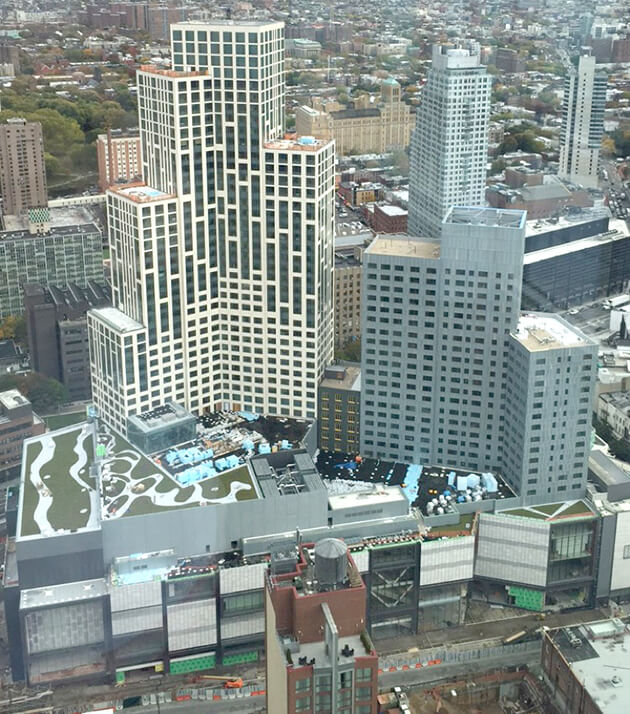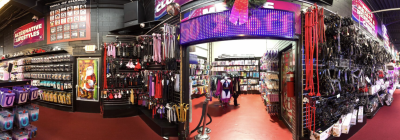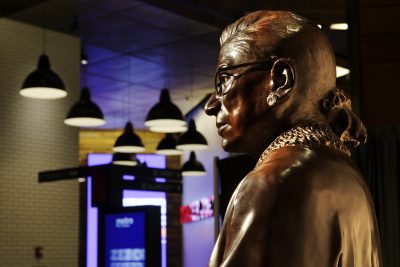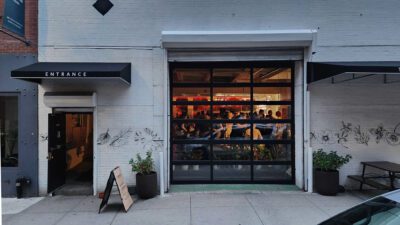Before the Deluge: A Preview Tour of the Wild, Weird World of the New Dekalb Market


City Point’s Towers and a five-story commercial space above the subterreanean Dekalb Market Hall. Photo by Jane Bruce
By now, you’ve likely heard about City Point, the development under construction in the Fulton Mall area of Downtown Brooklyn. But you may not understand how enormous it will be.
Three new residential towers will hold 1,290 units combined; a one-acre green space, Willoughby Square Park, will be installed beside them; a five-story, 675,000 square foot commercial center will anchor two of the towers, plus hold a Century 21, Alamo Drafthouse Cinema, and City Target; and—beneath all of that—around 40 food and drink vendors and a full Trader Joe’s will fill 30,000-square feet in what will be known as Dekalb Market Hall. And for anybody who cannot quote figure out how to use mass transit or, you know, walk, there will also be a 700-car parking garage installed underground. The 1.9 million-square feet of new construction is, collectively, the largest mixed-use development in all five boroughs, and it will be fully finished by next fall.
While big name developers like Washington Square Partners, Acadia Realty Trust, and Brodsky Organization are behind the development, there is one woman in charge of what we think is the coolest part of the whole venture: selecting the food vendors inside Dekalb Market Hall. Her name? Anna Castellani.
“You’ve got towers going in, and nobody’s feeding them. There’s no food anywhere,” Castellani told us last week, standing just beside the gigantic and still-very-under-construction site off of Fulton Mall.
Food options in the immediate vicinity are limited to lots and lots of chains. A lot of the reason for this is that Downtown Brooklyn’s Fulton Mall strip is one of the most profitable commercials retail centers in the United States. For example, the Macy’s on Fulton, despite looking somewhat worse for the wear, is actually one of that company’s most profitable in the country, and is even about to get a $100 million makeover infusion. Ground floor commercial rents in Downtown Brooklyn are among the most expensive in the borough, on average, they’re $287 per square foot. All of which is to say only the most profitable business and established brands, like Chipotle and Shake Shack, can afford to exist here.
When Paul Travis, managing partner at Washington Square Partners, first reached out to Castellani about heading up the Market Hall eight years ago, Castellani agreed to the project under one condition: that she could circumvent market rates in order to take on less-established and local vendors, or “a lot of really cool, fun, smaller-type bistros,” as she describes them to me. “You’ve got to appeal to the younger demographic that is going to be moving here,” says Castellani. “These are all young professionals that will be in these units. These are one-bedroom studios that are going up.”
Castellani grew up just down the block from the colossal development she is now in charge of outfitting with food. At the time, residences in Downtown Brooklyn were almost non-existent. This has changed dramatically in the last few years and will continue to as construction continues apace. Castellani got her start in the food world with the Dumbo General Store (which has since been bought and transformed into the Italian restaurant AlMar). In 2005, Castellani, along with her husband and business partner Richard Lamb, opened the high-end gourmet market Foragers. In 2012, the couple expanded the business to 22nd Street in Chelsea, adding on a wine shop and restaurant. They also own a farm upstate whose produce exclusively stocks their stores.
In 2008, zoning changes in Downtown Brooklyn were finally passed and, as Castellani points out, downtown Brooklyn became a free-for-all. “It’s got every major subway line coming into it, surrounded by brownstone Brooklyn—it was like a sitting duck. So, yeah, it will be a totally different neighborhood.”
Castellani compared the impending changes to the other considerable and recent neighboring development, Barclay’s Center and Atlantic Terminal. “It’s very different in terms of [residential and commercial composition], but that has had a profound affect in terms of traffic patterns. Those are some of the top grossing outlets for the vendors there. We’re expecting the same thing.”
In conversation with Paul Travis from Washington Square Partners, Castellani was firm about what she wanted to create with the Market—what she thought the neighborhood was missing. “A real urban space. Not something that looks like it’s in a shopping mall, but that could exist outside of New York.” To gather ideas and get a better sense of what that could look like, she traveled, visiting Reading Terminal Market in Philadelphia—a little more “rough and ready” than what she is going for, but a place where everyone goes “whether you’re a suit or a construction person.” She also loved Grand Central Market in Los Angeles, a place that invites you to sit down and really eat, and where vendors have their own kitchens on site.
Luckily, says Castellani, she was given unrestricted room to pursue, essentially, whatever she wanted, which, in turn, meant her vendors could have the same freedom to design exactly the kind of places they wanted. “All the food vendors who are coming in are like crazy, passionate food vendors, you know? They’re not like corporate animals. So they’re all a little bit quirky and you want that to come across in their spaces. It’s a whole hodge-podge.”
To date, the Market is 50 percent leased; originally, there was space for 53 vendors, but that number will likely end up closer to 35 or 40 in sum, Trader Joe’s included. The vendors that came to her with their plans had different requirements, and she allowed them to take the space they needed.
And, speaking of vendors: The hard part has not been getting them, it has been picking the right ones. “I’ve gotta love, love, love the tenant’s food,” Castellani says, standing in a hard hat in the cellar—currently a cavernous, and barren construction site—which will soon be the Market’s home. “It’s not about whether they can pay.”
Sometimes, businesses who knew Castellani was managing the market would write and make their pitch by email, others who reached out had worked with her over the years. There will be a Polish pierogi vendor, for example, who approached her, simply saying: Nobody in the city is making a pierogi the right way. Castellani’s reply: Hop on board. In addition to the full-scale Trader Joe’s (which Castellani also felt was the right grocery store brand for a younger demographic), there will be a Pain D’Avignon, one of the largest whole-sale bread bakers in New York, who currently have a facility in Queens, but will now have space to bake on site in the food hall, where they will also serve alternative flour and ancient grain breads, in addition to traditional pastries.
Other vendors include Coolship Beers from Portland, Maine; Home Frite; Nobletree Coffee, based in Williamsburg; Fulton Landing Seafood Company; Fletchers; Bun-Ker, Ridgewood’s vietnamese sensation; Got Cake!, a small cake-maker in Brooklyn; Smorgasburg vets Duck Season; and, of course, Katz’s Deli.
It is only slightly hard to envision that, in less than a year, this 30,000-square-foot shell will be one of the major food-hubs in all of Brooklyn. Aesthetically, Castellani says there will be a lot of neon signage installed and—to get downstairs—there will be two escalators and a direct portal to the Dekalb B/Q stop. It is built to be not just a transit hub, but an “everything hub,” says Castellani.
Initially, Castellani says the idea of being in the cellar was not that exciting. Quickly, she saw its advantage: staying open until 2:30am and making a lot of noise, without getting any complaints from the neighbors. Currently, there is no obvious destination for the Barclay’s post-game and concert crowd. Dekalb Market will fill that hole. Somewhat stranger than that, Castellani points out, if you live in the building, or anywhere near it, once you enter, you sort of never have to leave. You can go grocery shopping, clothes shopping, and see a move at Alamo Drafthouse all in the same vertical space.
“I’m hoping you can come multiple times in a day, you’ll need to, it’s too much,” says Castellani. Why not make it your one-stop chowdown for breakfast, lunch, dinner, and drinks? Maybe a bit much, but it is an honest-to-goodness possibility.
I ask Castellani if she is overwhelmed, how she is managing it all. Her answer: She’s only dealing with food and people—her specialty—no construction. Hers is the business of creating an “emotional atmosphere,” which was one of the first things she and Paul Travis discussed eight years ago when she came on board; she wasn’t interested in just another space with a bunch of food stuffed inside of it. Travis felt Castellani understood that more than a lot of other developers, how to create a space that felt good.
“I don’t know why, but it never fazed me once,” says Castellani. “Maybe it should, but I don’t worry about it.”
Castellani understands the Brooklyn customer will call out bad food when she eats it. “The Brooklyn customer is a very different customer than a Midtown customer or a Financial District customer,” says Castellani. “They care about what they’re eating, they care about good food, you know? You can’t half-ass that.”
You might also like 


























